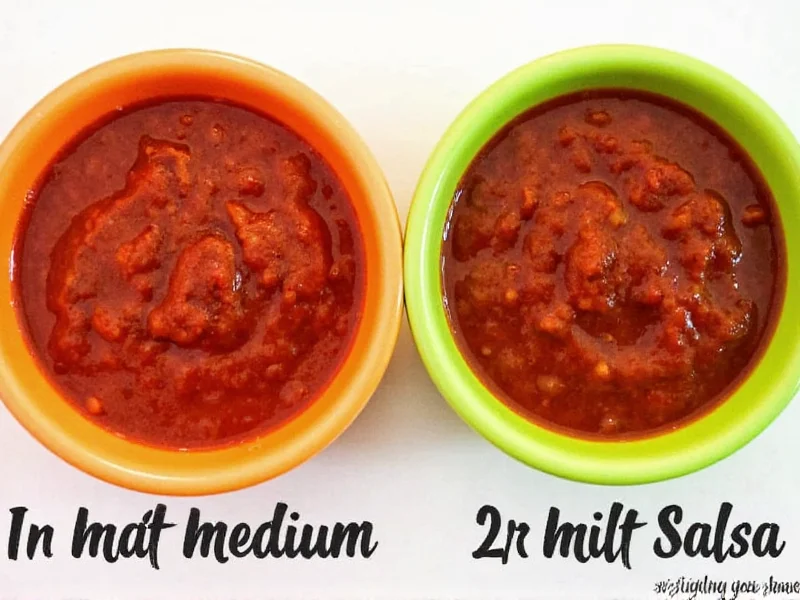Understanding salsa heat levels helps you make informed choices whether you're shopping for jarred products or ordering at a restaurant. The difference between mild and medium salsa isn't just marketing—it's based on measurable capsaicin content, the compound responsible for spiciness in chili peppers.
How Salsa Heat Levels Are Determined
Salsa heat is primarily determined by the types and proportions of chili peppers used. Most commercial producers follow consistent standards:
| Heat Level | Scoville Heat Units | Common Peppers Used | Flavor Profile |
|---|---|---|---|
| Mild | 500-1,500 SHU | Poblano, Anaheim, Bell peppers | Subtle warmth, vegetable-forward |
| Medium | 1,500-4,000 SHU | Jalapeño, Serrano (limited) | Noticeable heat with balanced flavor |
| Hot | 4,000-15,000 SHU | Serrano, Cayenne, Chipotle | Intense heat, smoky notes |
Why Medium Salsa Packs More Heat
The key difference between mild and medium salsa lies in pepper selection and preparation. Mild salsa typically uses only the flesh of milder peppers like poblanos or anaheims, avoiding the heat-concentrated seeds and membranes. Medium salsa incorporates jalapeños—which naturally contain more capsaicin—and often includes some seeds and membranes.
Food scientists measure salsa heat using High-Performance Liquid Chromatography (HPLC), which provides precise Scoville measurements. While mild salsa rarely exceeds 1,500 SHU, medium varieties typically range from 1,500-4,000 SHU—making them demonstrably hotter.
Factors That Affect Salsa Heat Perception
Several elements influence how hot a salsa feels, even within the same heat classification:
- Acidity level - Higher vinegar or lime content can amplify heat perception
- Sugar content - Some brands add sugar to mild salsas to counteract heat
- Tomato content - More tomatoes can dilute heat intensity
- Preparation method - Freshly made salsas often taste hotter than processed varieties
- Individual tolerance - Your personal heat sensitivity affects perception
Choosing Between Mild and Medium Salsa
Selecting the right heat level depends on your intended use:
- For sensitive palates or children - Mild salsa provides flavor without significant heat
- For balanced flavor with noticeable kick - Medium salsa offers the most versatile option for most adults
- When pairing with rich foods - Medium salsa cuts through fatty dishes like nachos or tacos
- For cooking applications - Medium salsa maintains flavor integrity when heated
Understanding the difference between mild and medium salsa heat levels prevents unpleasant surprises. If you're unsure, start with mild and work your way up—your taste buds will thank you.
Common Misconceptions About Salsa Heat
Several myths persist about salsa heat levels:
- "All medium salsas are equally hot" - Heat varies significantly between brands
- "Red salsas are always hotter than green" - Color doesn't determine heat level
- "Mild salsa has no heat" - Even mild varieties contain some capsaicin
- "Heat indicates quality" - Flavor balance matters more than pure spiciness
Adjusting Salsa Heat to Your Preference
Don't like your salsa's heat level? Try these adjustments:
- To reduce heat - Add diced avocado, sour cream, or extra tomatoes
- To increase mild salsa's heat - Stir in fresh minced jalapeño or hot sauce
- For consistent results - Taste test before serving to family or guests
- When cooking with salsa - Heat intensifies during cooking, so adjust accordingly
Whether you're comparing mild vs medium salsa for a party platter or selecting the perfect heat level for your tacos, understanding these distinctions ensures you get the flavor experience you want without unexpected burn.
Is medium salsa always hotter than mild salsa?
Yes, medium salsa is consistently hotter than mild salsa across commercial brands and restaurant preparations. Mild salsa typically ranges from 500-1,500 Scoville Heat Units while medium ranges from 1,500-4,000 SHU, making medium salsa demonstrably hotter.
What makes medium salsa hotter than mild salsa?
Medium salsa uses hotter peppers like jalapeños (sometimes with seeds and membranes included) while mild salsa typically uses milder peppers like poblanos or anaheims with seeds and membranes removed. The increased capsaicin content from these ingredients creates the noticeable heat difference between mild and medium salsa varieties.
How can I tell if a medium salsa is too hot for me?
If you're sensitive to spice, look for medium salsas that specify "mild-medium" or check ingredient lists for lower-heat peppers. Start with a small taste before serving to others. Remember that individual heat tolerance varies, and what seems medium to one person might feel hot to another when comparing mild vs medium salsa options.
Does the color of salsa indicate its heat level?
No, color doesn't reliably indicate heat level. Red salsas can be mild (made with roasted red peppers) while green salsas can be hot (made with serranos). The heat level depends on the specific peppers used and their preparation, not the color. This is important to understand when choosing between mild and medium salsa varieties.
Can I adjust the heat level of store-bought salsa?
Yes, you can modify store-bought salsa heat. To reduce heat in medium salsa, add diced avocado, sour cream, or extra tomatoes. To increase mild salsa's heat, stir in fresh minced jalapeño or a few drops of hot sauce. These adjustments help customize the heat level when the difference between mild and medium salsa doesn't match your preference.











 浙公网安备
33010002000092号
浙公网安备
33010002000092号 浙B2-20120091-4
浙B2-20120091-4